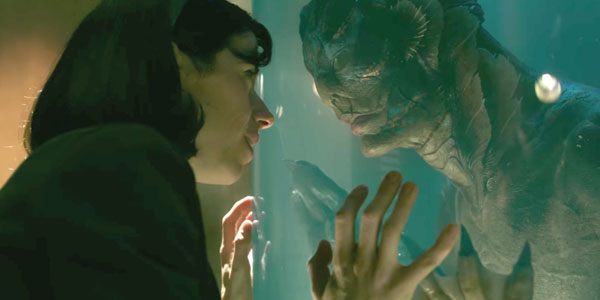
Guillermo del Toro was nervous. It was a Friday night in January, and he was waiting to see the first U.S. audience numbers for his film, “The Shape of Water.” These numbers usually indicate whether a movie will be successful or not. His film had received acclaim at the Venice Film Festival and gotten a great review in The New York Times, but would moviegoers want to see a love story about a woman and amphibious man?
Del Toro was optimistic, but he would have to wait. Meanwhile, he had to keep promoting his movie in interviews. I spoke with him and asked if he thought “The Shape of Water” was the best film he’d made. Del Toro was completely honest. “I think so,” he said. “I’d rank them as follows: ‘The Shape of Water,’ ‘The Devil’s Backbone’ and ‘Pan’s Labyrinth.’”
One of del Toro’s biggest challenges with this movie was to tell a love story in a world on the brink of the apocalypse. “The film takes place in 1962 during the Cuban missile crisis, the coldest part of the Cold War,” he said. “This is a moment when thinking about love is absolutely impossible … I think it’s precisely at these times when you can’t talk about love that you must absolutely talk about love.”
Another challenge was to find beauty in situations that would ordinarily evoke fear. Del Toro had to create a ghastly creature that people would want to get to know, and eventually, learn to love. The film’s leading man — the creature, or “the Asset” — is an amphibious man; sensuous and broad-shouldered, with piercing eyes. “The idea was not only making him sensual, but also perfect,” he told me. “That is, we wanted him to be like the Michelangelo’s ‘David’ of creatures. We wanted him to look like a perfect swimmer. He’s not a monster that exists only as an animal; he exists as a primitive water god.”
Del Toro, who has been nominated for the Academy Award for best director for “The Shape of Water,” wanted to make a different monster movie — one where the monster hasn’t lost everything by the end. “I wanted, for once in the history of cinema, for King Kong to get Fay Wray, or for the Creature from the Black Lagoon to live happily ever after with the woman he loves,” del Toro said. “My film is completely relevant for the present times.”
The present times are times of a Trump administration in the United States, and of dead bodies piling up in Mexico. “My films portray monsters as symbols,” del Toro explained, “but the actual monsters in my films are humans … I don’t want people to scream or jump in their seats, I’m not very interested in that.” We veered from fiction to reality while we talked. Del Toro told me how “brutal” and “terrible” it was to work in Hollywood with Bob Weinstein, the brother of Harvey Weinstein, the disgraced movie executive who has been accused by multiple women of sexual harassment.
Del Toro also spoke about dealing with real monsters in Mexico, namely the ones who kidnapped his father in 1998. The kidnapping forced del Toro to leave Mexico, and Hollywood convinced him to stay here. But he remains emotionally connected to Mexico and to its politics.
Mexico will elect a new president in July, and del Toro believes change is the only alternative to set the nation back on the right course. “Change must come from us,” he said. “The media, citizens, we are the strongest agents of change.”
Mexico has some of the best directors in the world. Alejandro González Iñárritu and Alfonso Cuarón have both won Oscars in recent years, and del Toro seems to be on track to be the third. But Mexico also has some of the worst and most corrupt politicians in the Americas. We’re experts when it comes to fiction, but not that great when it comes to reality.
After our discussion ended, del Toro still had about 45 minutes more to endure before he would get his audience numbers. He did not know then that the best time of his professional life was about to begin.
(Jorge Ramos, an Emmy Award-winning journalist, is a news anchor on Univision.)
___________________________________________________________________________________
Los Monstruos de Guillermo del Toro
Guillermo del Toro estaba ansioso. Era un viernes por la tarde en enero, y dentro de una hora le iban a entregar las primeras cifras de asistencia a su película, “La Forma del Agua”, en Estados Unidos. Esos números suelen pronosticar si un film va a ser comercialmente exitoso o no. Su obra había sido muy elogiada en el Festival de Cine de Venecia, y la reseña del diario The New York Times era extraordinaria. Pero ¿querría la gente ver como un hombre-pez se enamora de una mujer?
Del Toro estaba optimista pero habría que esperar. Y en lo que llegaban esos números, le tocaba dar entrevistas para la promoción. ¿Será esta la mejor película de tu vida? le pregunté. Y me contestó con absoluta honestidad. “Yo creo que sí”, me dijo. “Para mí el orden es ésta: ‘La Forma del Agua’, ‘El Espinazo del Diablo’ y ‘El Laberinto del Fauno’”.
Uno de los retos de la película era encontrar el amor cuando el fin del mundo era una posibilidad. “Justamente la película tiene lugar en 1962, en la crisis de los misiles en Cuba, en lo más frío de la Guerra Fría”, me explicó. “Es un momento en que es absolutamente imposible pensar en el amor … creo que son los momentos en que no se puede hablar del amor en los que hay que hablar del amor”.
El otro desafío era encontrar la belleza y el amor en formas que, generalmente, suelen generar odio y miedo. Más que un monstruo amoroso, del Toro creó una repugnante criatura a la que había que abrazar, conocer y aprender a amar. El protagonista — la criatura, o “the Asset” en inglés — era un hombre-pez, sensual, de espaldas anchas, cintura pequeña y mirada de conquistador. “La idea no era só–lo la sensualidad, sino crear una idea de perfección”, me comentó del Toro. “Es decir, vamos a crear el ‘David’ de Miguel Ángel de las criaturas. Vamos a darle un físico de nadador perfecto. No es un monstruo que existe como animal únicamente. Existe también como un dios primigenio del agua”.
La mente y los ojos de del Toro están llenos de monstruos que, al final de la película, lo perdieron todo. Él quería esta vez algo distinto: “La semilla surge en la idea de que me gustaría, por una vez en la historia del cine, que King Kong se pudiera llevar a Fay Wray, o que el Monstruo de la Laguna Negra pudiera vivir para siempre con la mujer que ama. (Mi película) está muy viva para el momento de ahora”.
El momento de ahora es el del presidente Donald Trump en Estados Unidos y el de los muertos que se amontonan en México. “La vocación de mi cine es mostrar al monstruo como una suerte de símbolo”, me cuenta, “pero los monstruos en mis películas son los humanos. … Mi vocación no es el susto ni el brinco; no me interesan mucho”.
La frase de del Toro es muy fuerte: “Los monstruos en mis películas son los humanos”. Así nos salimos de las películas para caer en la realidad. Y de pronto me cuenta lo “brutal” y “horripilante” que fue trabajar en Hollywood con Bob Weinstein, el hermano de Harvey Weinstein, este último acusado de muchos casos de acoso sexual.
En México del Toro también tuvo sus monstruos — los que secuestraron a su padre en 1998. Ese secuestro, de alguna manera, lo empuja fuera de México. Hollywood luego se encargaría de atraparlo en Estados Unidos. Pero él sigue conectado emocionalmente a México y a sus ritmos electorales.
El próximo julio se escoge presidente en México y para del Toro la única alternativa es el cambio. “El cambio lo vamos a dar como ciudadanos”, me dijo. “Los medios, los ciudadanos, somos los que más podemos ser agentes del cambio. Ahorita es realmente un retroceso”.
La gran ironía es que México tiene a algunos de los mejores directores de cine del mundo — Alejandro González Iñárritú y Alfonso Cuarón ya ganaron un Oscar, y todo parece indicar que del Toro va por el tercero — pero también ha tenido a algunos de los peores y más corruptos presidentes del hemisferio. Somos expertos manejando la ficción. La realidad, aparentemente, nos cuesta más trabajo. Pero en ambos campos sabemos construir el horror.
La entrevista había terminado, pero a del Toro aún le quedaban 45 minutos de ansiedad. Lo que él no sabía es que el mejor momento de su vida estaba a punto de empezar.
(Posdata: Aquí pueden escuchar mi “podcast”con Guillermo del Toro: bit.ly/2sIxI4y.)
(Jorge Ramos, periodista ganador del Emmy, es el principal director de noticias de Univision Network. Ramos, nacido en México, es autor de nueve libros de grandes ventas, el más reciente de los cuales es “A Country for All: An Immigrant Manifesto”.)Guillermo del Toro’s Monsters










